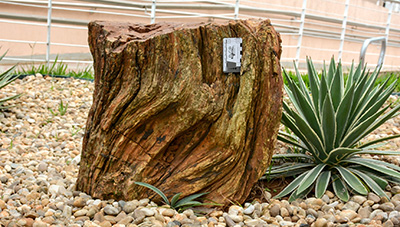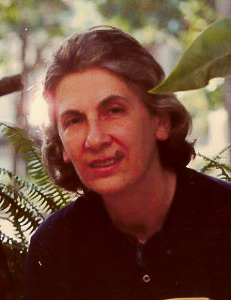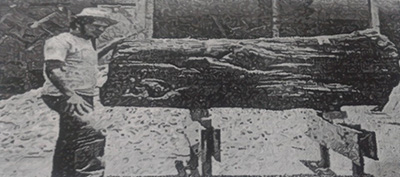Diana Mussa. Photo: public domain.
The geologist and paleontologist Diana Mussa was the first Brazilian paleobotany of international prestige, leaving us a meticulous and voluminous work and being recognized as a world authority in Devonian floras.
Born in Campos dos Goytacazes (RJ) and daughter of immigrants Nagib David Mussa and Maria Chacur Mussa (from Tripoli, Lebanon), in 1952 Diana moved to Rio de Janeiro and ingressed in the National Faculty of Philosophy of the University of Brazil (named as Federal University of Rio de Janeiro since 1965), to study Natural History. There she was a classmate of Maria Martha Barbosa and a student of the teachers Júlio Magalhães and Nicéa Magessi Trindade. Restless, dedicated, and thirsty for knowledge, she also studied geology at same institution. During this period, she deepened his studies by doing internships with great researchers, both in botany and geology. In this way, it acquired all the basis for the preparation and study of extant woods with Dr. Fernando R. Milanez, in the Botanical Garden of Rio de Janeiro, and received support from the paleobotanists Friedrich Wilhelm Sommer, Elias Dolianiti and Richard Kräusel. On March 7, 1958, she joined fifteen other pioneer Brazilian paleontologists to found the Brazilian Society of Paleontology and to participate, in the following year, of the 1o Brazilian Congress of Paleontology, held in Rio de Janeiro.1,2.
Diana faced teaching as a true priesthood, beginning in 1949 as a teacher of natural sciences in the basic education of basic public schools of Rio de Janeiro. At the end of the 1950s, driven by her intense love and desire to devote himself to the underprivileged people, she joined the Order of Saint Clara and was sent to manage a school in Manaus, Amazonas state. In 1958 she visited the amazonian city of Tefé, where conducted research on fossil wood in parallel with the religious mission she took on there. Later, in 1961, he needed to return to his hometown for health care.
One of several silicified logs from Uberlandian outcrops of the Lower Cretaceous Botucatu Formation crammed into a marble factory and rescued from there by the professor Luiz Nishiyama (Institute of Geography-UFU) and reported in 1972 by geologists Kenitiro Suguio and Armando Márcio Coimbra. Photo taken from Suguio & Coimbra (1972).
Shortly after returning from Amazonas, Diana was hired as a research technician at the National Nuclear Energy Commission and, in 1973, she began his postgraduate studies at the Institute of Geosciences of the University of São Paulo under advisory of Dr. Antonio Carlos Rocha-Campos (1937-2019). During this period received parts of permineralized logs from the former Sobradinho Farm in Uberlandia (nearness the current campus of IFTM Uberlândia), outcrops identified in 1972 by geologists Kenitiro Suguio and Armando Márcio Coimbra as being from the Botucatu Formation of the Paraná Basin3. Through detailed studies with the purpose of identifying and describing that specimens, Diana Mussa correlates it to wood structure of the extant Pinaceae familiy by its morphological affinities, and allocating the fossil woods in the extinct group Protopinaceae. After detailed analysis, found affinities with the genera Pinuxylon and Protopinuxylon, but the slight divergences between the groups and the Uberlandian material led her to describe in 1974 the new genus Paleopinuxylon, similar to the current Pinus, and containing the species Paleopinuxylon josuei, the third species described in his career so far, and with which she honors the friend and fellow paleontologist Josué Camargo Mendes (1918 - 1991)4. In 1982 she obtain his PhD, with with honor, dealing with the Permian woods of the Paraná Basin.

The now Dr. Diana Mussa has became researcher at the National Department of Mineral Production, and in 1983 she was requested by National Museum. There, she conducted research, guided students and taught in Paleobotany, Floristic Paleobiology, Evolution, Paleoecology and Geology. In 1993, after going through a public contest, she was appointed as Professor at the National Museum. Throughout her career, Diana Mussa has described thirty-three new genera of fossil plants, and has been honored with the genus Mussaeoxylon Merlotti, 1998.
In addition to maintaining her academic activities, in the mid-1990s Diana returned to religious life as a lay sister linked to the Archdiocese of Rio de Janeiro and devoted herself to spiritual tasks and the study and teaching of Hebrew. In 2003, with deep regret for feeling that she could still collaborate a lot, she was compulsorily retired at age 70. Only four years later, without any illness, Diana left this world without major suffering, victim of cardiac arrest on May 8, 2007.
Diana Mussa deeply lived the passion for her work. She was a determined woman and competently imposed herself in a field absolutely masculine. She reached her childhood dream and became a naturalist in the broad sense. In choosing Paleobotany, mainly anatomy of fossil woods, she assumed all the difficulties inherent to a research program almost nonexistent in that time in Brazil. Developed all the skills needed for full research, from field fossil prospecting to the laboratory, where dedicated herself to the hard preparation of fossils logs for study, always paying attention to the different materials and adaptations of existing techniques; Moreover, she was extremely careful in his microcospic observations and was not content to only photograph the materials, illustrating the anatomy of the fossil wood with great clarity in interpreting them three-dimensionally. Her "why questions" have always gone far beyond the mere morphological or anatomical description of the fossils, as she was concerned with the development and evolution of the plants as well as the reconstruction of their life and death environments. With a beautiful career and even having published only in Portuguese, Diana Mussa is internationally recognized as the largest paleobotanist that Brazil has ever had.


